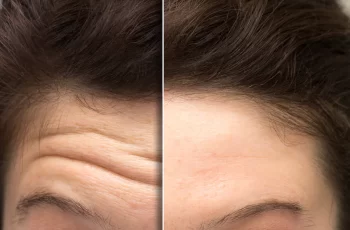
Can You use Niacinamide and Glycolic Acid Together?
There’s a lot of noise surrounding how to use various skincare ingredients, at times it can feel quite deafening. With the promise of clarity and skin concerns erased overnight, I wouldn’t be surprised to hear you’ve thrown all caution to the wind and slathered your skin in every product sitting on your bedroom cabinet. This could cause you some problems, especially if those products contain active levels of glycolic acid and niacinamide.
Both niacinamide and glycolic acid deliver similar results for the skin. They both improve the skin texture, flare-ups in breakouts such as acne, reduce the appearance of ageing (such as fine lines and wrinkles) and target areas of hyperpigmentation.
Although it may seem a good idea to layer niacinamide on top of glycolic acid there is an important part of skincare that you should always keep in mind. What I mean is how each product formula comes with a different pH level. Now, this may not seem important, but imbalanced pH levels are usually the cause of skin irritation, redness, and dryness. With different pH levels means the time it takes for each ingredient to absorb into the skin can vary, sometimes it can take seconds, a few minutes or even up to 30 minutes. One simple way of remembering how long it’ll take is the higher the pH level, the longer amount of time it needs to absorb into the skin. With niacinamide having a higher pH level than glycolic acid, it will take a lot longer to absorb into the skin, and even then it wouldn’t penetrate as far down as glycolic acid.
Now if you are still a little muddled with how these ingredients can even work together, I’m going to now answer some of the common questions about using niacinamide and glycolic acid together.
Can I mix glycolic acid and niacinamide?
Yes, you can, but ensure you use them correctly. What I mean by this is allowing enough time in between applying each ingredient to avoid any irritation. As I have already mentioned, niacinamide pH level is higher and more alkaline than glycolic acid. Therefore, it advisable to avoid using them at the same time, so for optimal results apply glycolic acid first, allow a few minutes to pass before applying niacinamide over the face.
If you are wanting to know more about how to mix niacinamide and glycolic acid together check out our dedicated blog post.
How do you use niacinamide and glycolic acid?
To use niacinamide and glycolic acid effectively together you must allow enough time in between applications. This will not only allow the ingredients to absorb into the skin but will leave enough time to pass to ensure you have avoided any potential irritation. The order in how you apply skincare products is also an important factor when using niacinamide and glycolic acid. You may already know that to reap the rewards and have an effective routine requires you to apply your products from the thinnest consistency to thickest. This, therefore, means you’ll apply glycolic acid to the skin before niacinamide as the acid is usually formulated into products such as exfoliating toners, compared to niacinamide which is found in more serums and moisturisers.
What can you not mix with niacinamide?
Although niacinamide is extremely hydrating, you will find that there are some active ingredients that should be avoided when using it in your daily skincare regime. You can find out more over on our dedicated blog post about what can you not mix with niacinamide.
What goes well with glycolic acid?
There are a couple ingredients that can be teamed with glycolic acid, however, before I share with you some of the most effective combinations, do consult with a doctor or dermatologist to ensure any ingredients you are introducing to your skin will not cause irritation or redness.
Glycolic Acid & Salicylic Acid
This combo of potent BHA and AHA is great for those with an oily skin type that is prone to breakouts. Each acid works in different layers of the skin ensuring any clogged pores are cleared whilst the layer of dead skin cells that are found on the outer surface are sloughed away. Together these chemical exfoliants can rid the skin of acne forming impurities, giving you an all-over healthy complexion.
Glycolic Acid & Lactic Acid
Although glycolic acid and lactic acid belong to the same AHA family due to their different molecular size, they can work on different areas of the skin. Lactic acid has a large molecule size meaning it works on the outer surface, whilst glycolic acid can reach further into the skin and work at removing excess oil, bacteria and impurities found in the lower layers.
Glycolic Acid & Hyaluronic Acid
Hyaluronic acid is one of the rare ingredients that can be used by all skin types. It can deliver a boost in hydration with its humectant properties locking water into the face resulting in a continuous moisturisation. This makes hyaluronic acid an ideal teammate for glycolic acid as it can counteract any signs of irritation or dryness that can potentially occur when using the potent AHA.
There you have some prime examples of some ingredients that work well with glycolic acid. Before applying any products to the skin however, I suggest performing a 24-patch test on the inside of your forearm before applying it to the face.
Can niacinamide be used with AHA BHA?
Yes, but with caution. As I have already mentioned pH levels of skincare formulations play an important role in how they react on the skin. With the high alkaline level of niacinamide resulting in it taking longer to absorb compared to the potent and acidic AHAs, such as glycolic acid, lactic acid and BHA such as salicylic acid.
Can I use glycolic acid every day?
You can indeed, if you skin has built its tolerance and is happy for a daily application you can use glycolic acid every day. Those with a normal, combination or oily skin type will benefit the most from the exfoliating effects of glycolic acid. If you tend to have a dry skin type it is best to avoid glycolic acid and instead opt for lactic acid or PHA as these are gentler on the skin.
Can I use moisturiser after glycolic acid?
Absolutely, using a moisturiser after glycolic acid will combat any dryness whilst forming a protective barrier over the skin. This physical barrier on the outer surface of the skin will prevent any environmental aggressors causing any damage or imbalance to the protective barrier.
Now, with any luck I have cleared up some of the confusion surrounding using niacinamide and glycolic acid together, but if you have any more do come and follow us on Instagram.


